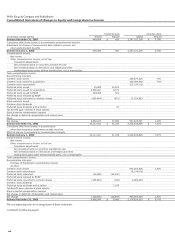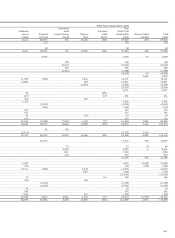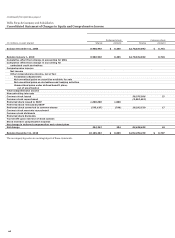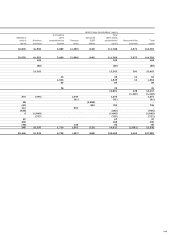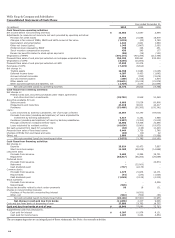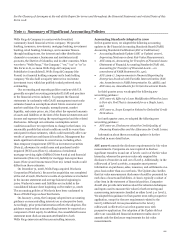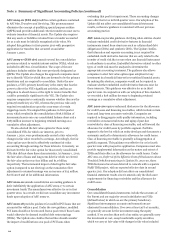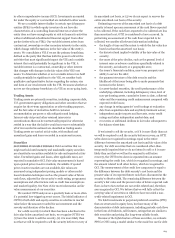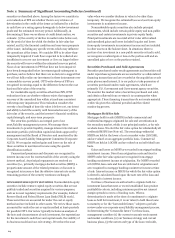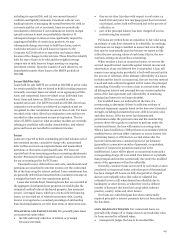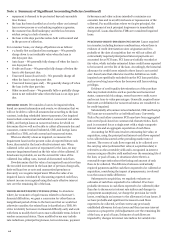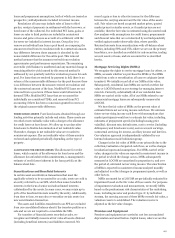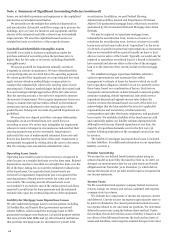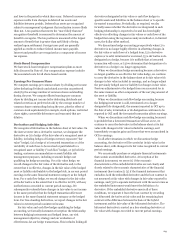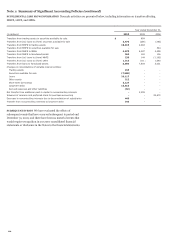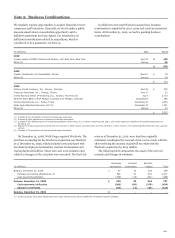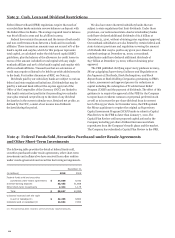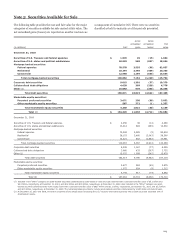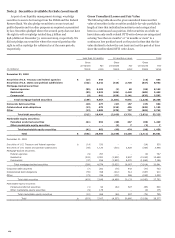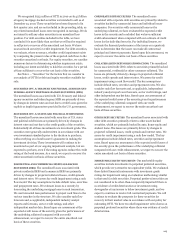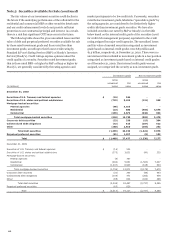Wells Fargo 2010 Annual Report Download - page 118
Download and view the complete annual report
Please find page 118 of the 2010 Wells Fargo annual report below. You can navigate through the pages in the report by either clicking on the pages listed below, or by using the keyword search tool below to find specific information within the annual report.Note 1: Summary of Significant Accounting Policies (continued)
• repayment is deemed to be protracted beyond reasonable
time frames;
• the loan has been classified as a loss by either our internal
loan review process or our banking regulatory agencies;
• the customer has filed bankruptcy and the loss becomes
evident owing to a lack of assets; or
• the loan is 180 days past due unless both well-secured and
in the process of collection.
For consumer loans, our charge-off policies are as follows:
• 1-4 family first and junior lien mortgages – We generally
charge down to net realizable value when the loan is
180 days past due.
• Auto loans – We generally fully charge off when the loan is
120 days past due.
• Credit card loans – We generally fully charge off when the
loan is 180 days past due.
• Unsecured loans (closed end) – We generally charge off
when the loan is 120 days past due.
• Unsecured loans (open end) – We generally charge off when
the loan is 180 days past due.
• Other secured loans – We generally fully or partially charge
down to net realizable value when the loan is 120 days past
due.
IMPAIRED LOANS We consider a loan to be impaired when,
based on current information and events, we determine that we
will not be able to collect all amounts due according to the loan
contract, including scheduled interest payments. Our impaired
loans include commercial and industrial, commercial real estate
(CRE), and foreign loans on nonaccrual status for which we
determine that we will not be able to collect all amounts due and
consumer, commercial and industrial, CRE, and foreign loans
modified in a TDR, on both accrual and nonaccrual status.
When we identify a loan as impaired, we measure the
impairment based on the present value of expected future cash
flows, discounted at the loan’s effective interest rate. When
collateral is the sole source of repayment for the loan, we may
measure impairment based on the fair value of the collateral. If
foreclosure is probable, we use the current fair value of the
collateral less selling costs, instead of discounted cash flows.
If we determine that the value of an impaired loan is less than
the recorded investment in the loan (net of previous charge-offs,
deferred loan fees or costs and unamortized premium or
discount), we recognize impairment. When the value of an
impaired loan is calculated by discounting expected cash flows,
interest income is recognized using the loan’s effective interest
rate over the remaining life of the loan.
TROUBLED DEBT RESTRUCTURINGS (TDRs) In situations
where, for economic or legal reasons related to a borrower’s
financial difficulties, we grant a concession for other than an
insignificant period of time to the borrower that we would not
otherwise consider, the related loan is classified as a TDR. We
strive to identify borrowers in financial difficulty early and work
with them to modify their loan to more affordable terms before it
reaches nonaccrual status. These modified terms may include
rate reductions, principal forgiveness, term extensions, payment
forbearance and other actions intended to minimize our
economic loss and to avoid foreclosure or repossession of the
collateral. For modifications where we forgive principal, the
entire amount of such principal forgiveness is immediately
charged off. Loans classified as TDRs are considered impaired
loans.
PURCHASED CREDIT-IMPAIRED (PCI) LOANS Loans acquired
in a transfer, including business combinations, where there is
evidence of credit deterioration since origination and it is
probable at the date of acquisition that we will not collect all
contractually required principal and interest payments are
accounted for as PCI loans. PCI loans are initially recorded at
fair value, which includes estimated future credit losses expected
to be incurred over the life of the loan. Accordingly, the historical
allowance for credit losses related to these loans is not carried
over. Some loans that otherwise meet the definition as credit-
impaired are specifically excluded from the PCI loan portfolios,
such as revolving loans where the borrower still has revolving
privileges.
Evidence of credit quality deterioration as of the purchase
date may include statistics such as past due and nonaccrual
status, commercial risk ratings, recent borrower credit scores
and recent loan-to-value percentages. Generally, acquired loans
that meet our definition for nonaccrual status are considered to
be credit-impaired.
Substantially all commercial and industrial, CRE and foreign
PCI loans are accounted for as individual loans. Conversely,
Pick-a-Pay and other consumer PCI loans have been aggregated
into several pools based on common risk characteristics. Each
pool is accounted for as a single asset with a single composite
interest rate and an aggregate expectation of cash flows.
Accounting for PCI loans involves estimating fair value, at
acquisition, using the principal and interest cash flows expected
to be collected discounted at the prevailing market rate of
interest. The excess of cash flows expected to be collected over
the carrying value (estimated fair value at acquisition date) is
referred to as the accretable yield and is recognized in interest
income using an effective yield method over the remaining life of
the loan, or pool of loans, in situations where there is a
reasonable expectation about the timing and amount of cash
flows to be collected. The difference between contractually
required payments and the cash flows expected to be collected at
acquisition, considering the impact of prepayments, is referred
to as the nonaccretable difference.
Subsequent to acquisition, we regularly evaluate our
estimates of cash flows expected to be collected. If we have
probable decreases in cash flows expected to be collected (other
than due to decreases in interest rate indices and changes in
prepayment assumptions), we charge the provision for credit
losses, resulting in an increase to the allowance for loan losses. If
we have probable and significant increases in cash flows
expected to be collected, we first reverse any previously
established allowance for loan losses and then increase interest
income as a prospective yield adjustment over the remaining life
of the loan, or pool of loans. Estimates of cash flows are
impacted by changes in interest rate indices for variable rate
116


